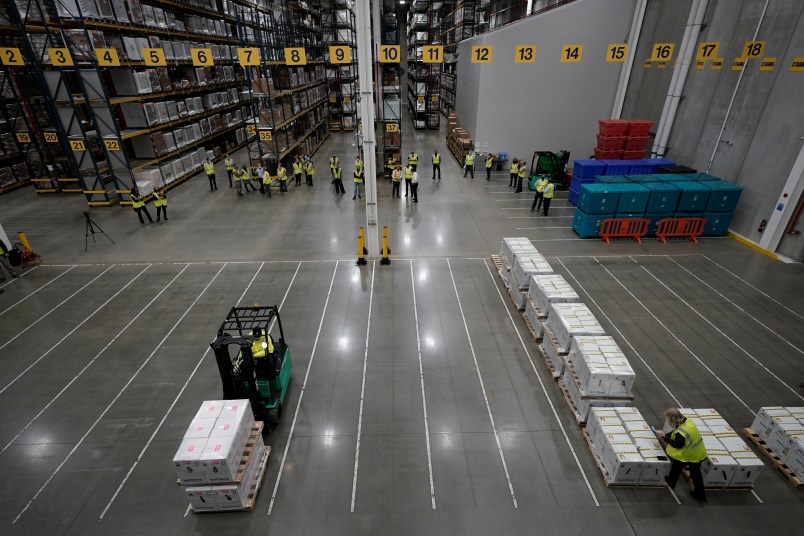Some major problems are already emerging in the initial rollout of the COVID-19 vaccine, and the federal government is not providing any good answers.
The early warning signs:
- At least twelve states are reporting cuts in their initial allocations of doses.
- One governor is reporting that the total number of doses projected to be available nationwide has been cut by four million monthly.
- The vaccine maker reports it is not having production problems and says it has doses in warehouses, but is awaiting direction from the federal government on where to send them.
The combination of no production problems plus doses sitting in warehouses suggests some issue with the federal government’s oversight of the distribution of the vaccine.
But it’s not exactly clear what the hold up is. The federal government has not offered an explanation for the shortfall in available doses.
The reduction was announced during a “CDC/OWS all-state call” Wednesday afternoon, Michigan Department of Health and Human Services spokesperson Lynn Sutfin told TPM.
Most disturbingly, Illinois Gov. J. B. Pritzker (D) suggested that the entire federal vaccine distribution effort was falling short of what had been expected. Federal officials with Operation Warp Speed have promised a monthly cadence of 20 million doses per each manufacturer per month. But Pritzker said that federal officials had told him that the Trump administration would only be able to distribute 4 million doses of the vaccine per week.
He added that his state would receive half of what it has expected of the Pfizer COVID-19 vaccine over the next two weeks.
In addition to Pritzker’s Illinois, California, Kansas, Nebraska, Maryland, Michigan, Washington, Indiana, Missouri, Iowa, Oregon, and Florida have said that they expected to receive less vaccine than federal officials had initially promised, offering different reasons for why.
A spokesperson for California Gov. Gavin Newsom (D) told TPM that the “federal government delayed the number of Pfizer vaccines that California will receive in the next shipment.” The spokesperson had no explanation as to why state’s allocation had been reduced.
Gov. Jay Inslee (D) of Washington state said that his state’s vaccine allocation had also been slashed by around 40 percent, without any explanation from federal officials.
“This is disruptive and frustrating,” Inslee said in a Thursday tweet.
.@CDCgov has informed us that WA’s vaccine allocation will be cut by 40 percent next week — and that all states are seeing similar cuts.
This is disruptive and frustrating. We need accurate, predictable numbers to plan and ensure on-the-ground success.
No explanation was given.
— Governor Jay Inslee (@GovInslee) December 17, 2020
Iowa’s Department of Public Health released a statement on Wednesday saying that the federal government had told it that Iowa, “as well as other states, will not receive the volume of vaccine initially anticipated.”
The statement said that Iowa would receive 30 percent fewer doses than expected, and that the state was “working to gain confirmation and additional details from our federal partners.”
In Nebraska, Gov. Pete Ricketts (R) said that his state had been told that its Pfizer allocation for next week would not come, “so that will be pushed off to the last week of December.” Angie Ling, the state’s Department of Health and Human Services incident commander, attributed it to a “supply chain problem,” but said that she didn’t know specifically what the nature of the problem was.
Florida Gov. Ron DeSantis (R) said on Tuesday that two shipments of around 450,000 doses were “on hold.”
“We don’t know whether we will get any or not,” DeSantis said. “And we’re just going to have to wait.”
The Florida Republican blamed it on manufacturing issues with Pfizer, but the pharmaceutical giant issued a statement denying that it was having problems in its production or delivery to the federal government.
“This week, we successfully shipped all 2.9 million doses that we were asked to ship by the U.S. Government to the locations specified by them,” the statement reads. “We have millions more doses sitting in our warehouse but, as of now, we have not received any shipment instructions for additional doses.”
Under the Trump administration’s vaccine distribution plan, federal officials arrange for doses of the vaccine to reach the state level. State officials then receive the doses and distribute the vaccine locally; lack of funding for the distribution effort at the state level has stoked fears that the effort to inoculate the country will run into serious problems.
But statements from state officials and Pfizer suggest that something in the federal distribution effort has led the Trump administration to scale back dose deliveries.
An HHS spokeswoman did not return TPM’s requests for comment regarding the Pfizer statement, or the cut dose-rates in general.
In what appears to a response to the reports, OWS denied that there had been any changes to the “official” planned allocations of the vaccine. The OWS statement came out before Pfizer announced it had doses sitting in warehouses awaiting further instructions.
The lighter shipments come as Trump administration officials have set incredibly rosy expectations for vaccine distribution, with HHS Secretary Alex Azar predicting that the vaccine would be widely available to the general public by February or March.
Operation Warp Speed officials contradicted that claim on Wednesday.
This story has been updated.







Gee, nobody could have predicted that we’d need to actually distribute the vaccine once it was manufactured.
Everyone was just supposed to drive by the plant, hang an arm out the window for their shot, then repeat in a few weeks.
Sheer incompetence or something worse is the question.
I feel like there is nobody in the government’s efforts who are smart enough to wipe their own asses. They just shit down their legs and decide that that is good enough.
I think it’s time for the trump admin to fuckoff and let serious people manage everything. This incompetence will not stand, man.
News about things everybody already knew or could have guessed.